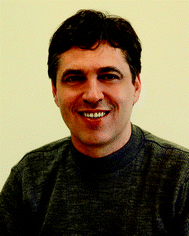Analytical atomic spectrometry in South America – increasing the development and international cooperation in atomic spectrometric analysis
Érico
Marlon de Moraes Flores

Universidade Federal de Santa Maria, Brazil. E-mail: ericommf@gmail.com
In the period 2015–2018, about 14% of publications from South America were in analytical chemistry in relation to all chemistry areas, with a field-weighted citation impact of 1.11 (“1” is the general world mean). Brazil is a leading country in analytical chemistry with the highest number of publications in South America. Brazil is among the top five countries regarding the number of submissions and between the top ten countries that have published articles in JAAS in the period of 2015 to 2017. Other countries including Argentine, Chile and Ecuador have also submitted many articles to JAAS.
In the same group as China, the USA, Spain and Canada, Brazil presents a large accept rate, higher than 50%. Also Argentine has a good accept rate (about 50%). Considering JAAS usage, Brazil is among the top 7 countries downloading JAAS articles, and in the last 3 years, 5–10% of the top cited articles in JAAS were from South America. These numbers show the relatively high contribution of South America to the success and increase of impact factor of JAAS (in some years articles from South America were even among the top five cited ones). It is clear that there is an increasing effort by the South American community to develop methods and applications in the analytical atomic spectrometry field.
This themed collection comprises 23 research articles dedicated to several atomic spectrometry fields that were performed by some of the best researchers working at South American universities and research institutes. They are related to special developments and applications using ICP-MS (with laser ablation or electrothermal vaporization), ICP-OES, LIBS, TXRF, PIXE, AFS and also HR CS GFAAS or molecular absorption spectrometry. It is hoped that this themed collection will contribute to increase the developments in these fields.
As expected, most articles were submitted by Brazilian researchers (19 articles, ∼82.6%) followed by Argentinean researchers (3 articles, ∼13%) and one article from Uruguay. An important aspect is the relatively high number of articles with international cooperation. About 1/3 of the articles were produced with collaboration with researchers from Canada (3 articles), the USA (2 articles), Scotland (1 article), Spain (1 article) and 1 between researcher of Argentine and Brazil. Interestingly, it was noticed that the corresponding authors for 50% of the articles were women (12 articles) representing a good gender balance for this collection.
More than 30 analytes were determined in the articles related to this collection, with special concern to toxic elements such as Hg, Pb, and Cd, but also essential elements such as Fe, Mn, Cu, and Zn among others. Some special applications were devoted to the development of methods for the determination of Au, Ir, Pd, Pt and Rh in sea water by ICP-MS using ultraviolet photochemical vapour generation. A similar approach was also used for the determination of inorganic Hg in petroleum polluted water, a matrix with a very high salt content. Five articles (about 22%) involved the application of LIBS for the analysis of cattle mineral supplements (Ca, Cu, Fe, Mn and Zn), high silicon content matrices (Al, Ca, Fe, Mg, Si and Ti), bovine and chicken meat (Ca, Mg, Na and K), metal alloys (Al, Cr, Cu, Fe, Mn, Mo, Ni, Ti, V and Zn) and polymers (Sb in electronic waste) with very good results. Regarding the analysis of polymers, generally a difficult task, an efficient digestion system was proposed for polymeric waste electrical and electronic equipment using ultraviolet light combined with microwave radiation, assuring suitable digests for analysis by ICP-MS that was virtually free of interferences.
Most applications were devoted to food or supplement analysis by a variety of techniques or combinations (HPLC-CV-AFS, ICP-MS, ICP-OES, TXRF, HR CS GFAAS and SPE-LC-ICP-MS). Work dealing with fossil fuels and derivatives (coal and petroleum coke) were also included in this collection with special applications using direct analysis by ETV-ICP-OES (As, Sb, Se and Te) or desolvating nebulizer system (DSN-ICP-OES) after acid or microwave-induced combustion (MIC, for further Ce and La determination). A study of sheathing devices for ICP-OES via nitrogen flow was presented showing the increase of plasma robustness. HR CS GFAAS was also applied to road dust analysis (Pb), soil and sludge samples (Hg), and also using multivariate and univariate regression models for minimizing interferences for soil analysis (Cd, Cr, Fe, and also Al by the AlH molecule-HR CS MAS).
Risk assessment of trace elements in airborne particulate matter was evaluated by solid sampling ETV-ICP-OES (As, Sb, Cd, Cu, Cr, Mn, Ni, Pb, Sr, V and Zn). Also, a standardless semi-quantitative analysis approach was proposed using PIXE with some advantages when applied to mineral thin and bulk samples. The feasibility of using internal standard for laser ablation coupled to ICP-MS was demonstrated for bioimaging plant leaves and the determination of Ag nanoparticles.
It is possible to see that the developed methods involved a wide range of analytes and a variety of matrices showing the diversity of work performed in South America. I would like to thank all authors that submitted articles for this themed collection and also to the reviewers that took the time and effort to review the submissions keeping the high quality standard of JAAS articles. Also, I must thank the Editorial and Advisory Boards of JAAS with special recognition to the JAAS staff for their dedicated work on this collection.
Érico Marlon de Moraes Flores
| This journal is © The Royal Society of Chemistry 2018 |

